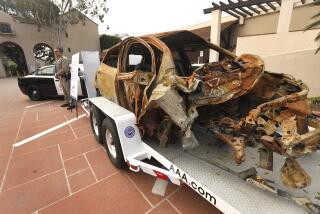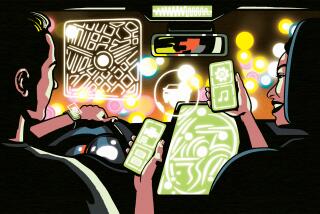The Wired Car: Is Productivity Worth the Risk?
- Share via
It isn’t enough that we can already spend every minute on the road fielding cellular phone calls from our bosses, spouses or creditors. Now, with General Motors’ announcement this month of voice-activated Internet access in cars equipped with its OnStar communications service, there will be no excuses for missing even electronic messages.
Already on the luxury market is the Clarion AutoPC, an add-on voice-activated in-dashboard computer, CD player and navigation system. Fully equipped versions, which can run more than $2,000, once seemed like lavish “smart” toys for the few drivers who could afford them.
Now GM’s OnStar Virtual Advisor, which will offer e-mail capability in selected vehicles by the end of next year, signals the opening of the mainstream market for Web cars.
OnStar subscribers--an audience expected to reach 1 million GM customers by the end of next year--will pay a yet-to-be-determined monthly fee for Virtual Advisor, on top of the current $199 for basic emergency service and the $695 dealership installation charge.
What that will buy them is access to personalized Internet data such as news headlines, sports scores and stock quotes, in addition to e-mail--all delivered by the same satellite-based system that currently provides navigation and emergency services. A feature called My OnStar, a personalized Web page, will even allow the driver to track the vehicle’s mileage and service history.
The technology is still evolving--Virtual Advisor can recognize only such basic commands as “yes,” “no,” “start” and “stop”--but GM expects rapid improvements, says Chet Huber, managing director for OnStar.
Virtual Advisor was developed in response to “customers’ demands for enhanced communications services delivered in a mobile environment,” says Huber, who notes that Americans spend 500 million hours a week in their vehicles.
*
So with a push of a button and a voice command, a computerized voice will read back all your e-mail messages--including, presumably, all the spam and trash-talking messages that show up in your desktop mailbox.
Sure, on-board e-mail opens up a whole new world of mobile productivity, just as car and cell phones have for millions of commuters. Think of all the business deals and daily tasks that can be completed as you’re stuck in traffic. But also think of all that cherished quiet time we’ll no longer enjoy.
Plus, do you really want to listen to all that e-mail being read by a digital voice? One peculiar downside is that you could be on kids’ carpool duty when the voice of Virtual Advisor relays one of those sleazy unsolicited e-mails offering a chance to chat with your fantasy dream gal or guy.
It’s certainly a possibility. Whatever e-mail comes your way will be read uncensored and unfiltered by the virtual voice, GM spokeswoman Jennifer Dunlap confirms.
Junk mail aside, the issue of safety is more unsettling. GM insists that the hands-free, voice-generated system will ensure safe driving because there are no screens or displays to distract drivers.
I don’t buy it. Whether you’re listening to a noisy child in the back seat or a computerized voice informing you that your stocks have taken a dive, you’re not fully focused on driving.
Although the initial Virtual Advisor will not include a screen or display board, future versions may indeed include such enhancements. The screens, however, would not be installed for driver viewing, GM insists.
Stephen Oesch, a spokesman for the Insurance Institute for Highway Safety, warns: “When any device is used, whether it’s a cell phone, VCR or Internet access, there is always a potential for distracting the driver.”
*
Concern over use of vehicle-based VCRs has already prompted some states to enact restrictions to ensure safety. California law, for example, dictates that TV screens must be out of the sight of the driver.
Even when a driver using a cell phone, changing radio stations or listening to e-mail is driving carefully, his or her attention may be diverted enough to affect the ability to react to road hazards or other drivers’ mistakes, Oesch cautions.
The National Highway Traffic Safety Administration has also raised safety questions.
“The general concern is that people [using Internet access] would be distracted from driving,” says spokesman Tim Hurd. The agency released a study in January that found that drivers using cell phones can become so distracted that they are at higher risk of accidents. Driver inattention from all causes, according to the study, is a primary factor in about half of all crashes in the United States.
A 1997 study published in the New England Journal of Medicine found that the risk of collision when using a cell telephone was four times higher than the risk when a phone was not being used.
The study, conducted by researchers at the University of Toronto, also found that the use of hands-free cell phones, as opposed to hand-held phones in the car, did not appear to lessen the risk of a crash, Oesch says.
On-board auto PCs may certainly increase our productivity and communication while commuting. Considering the number of hours we spend in our vehicles--especially in Southern California--the possibilities are exciting.
But drivers who plan on using the Internet while driving need to be responsible and drive safely--by focusing on the road, not on the e-mail.
*
Jeanne Wright cannot answer mail personally but responds in this column to automotive questions of general interest. Write to Your Wheels, Business Section, Los Angeles Times, Times Mirror Square, Los Angeles, CA 90053. E-mail: highway1@latimes.com.






